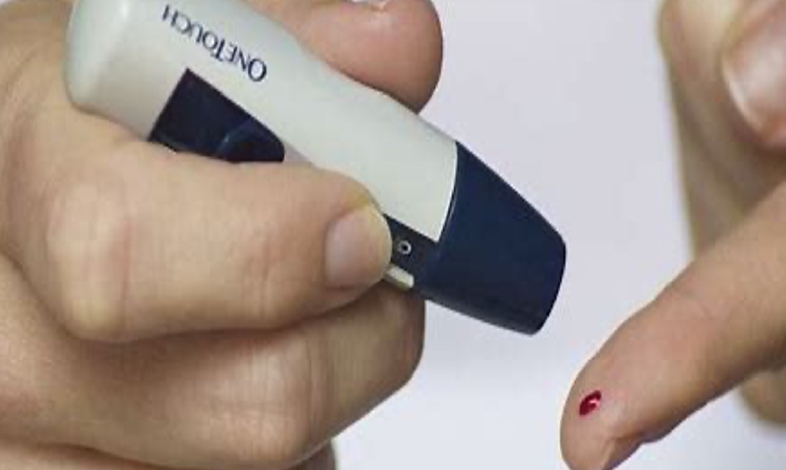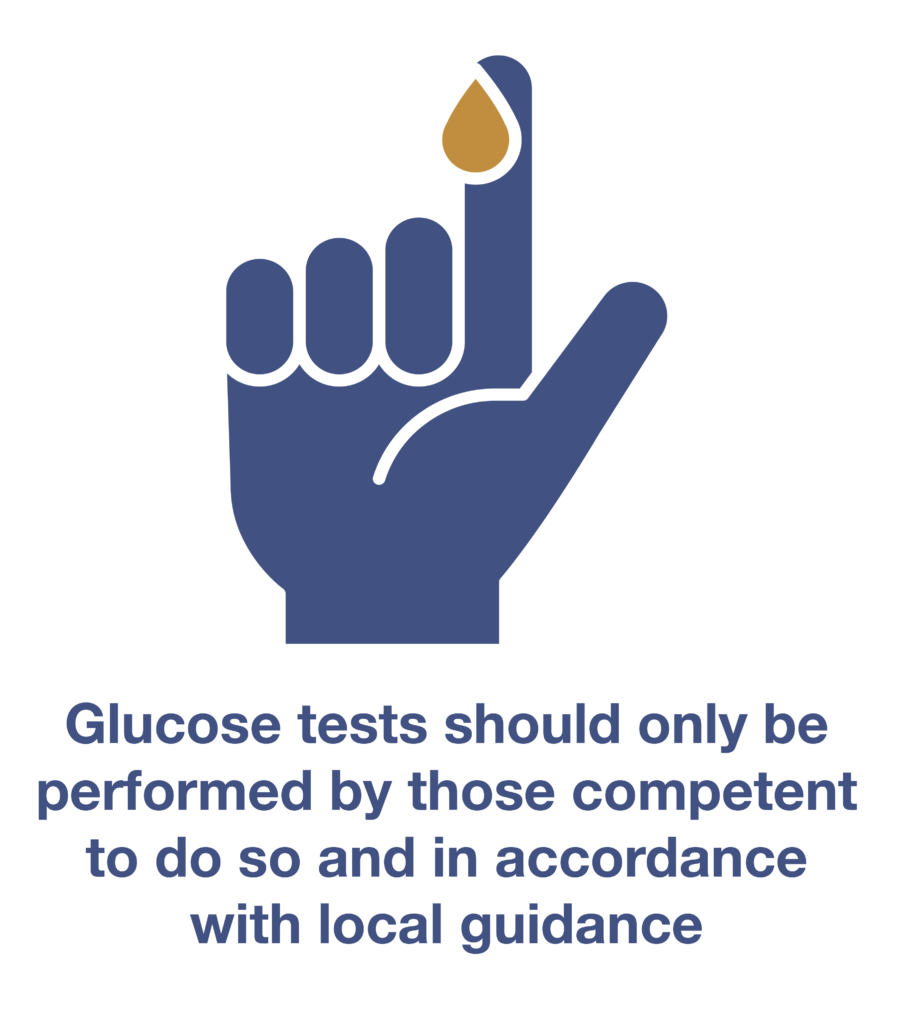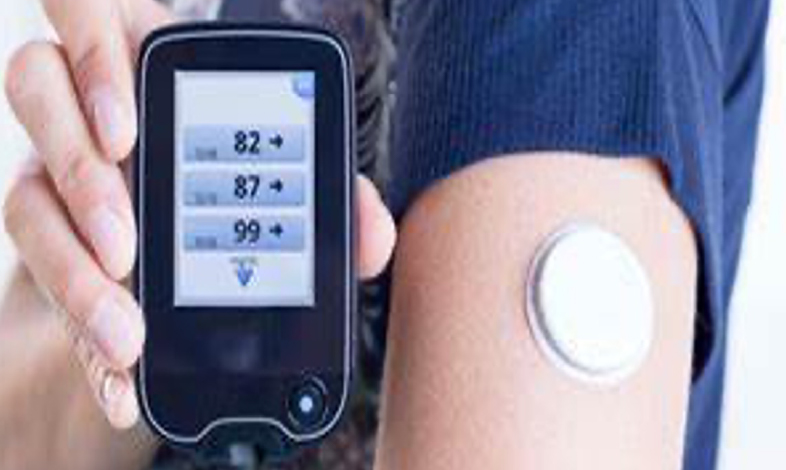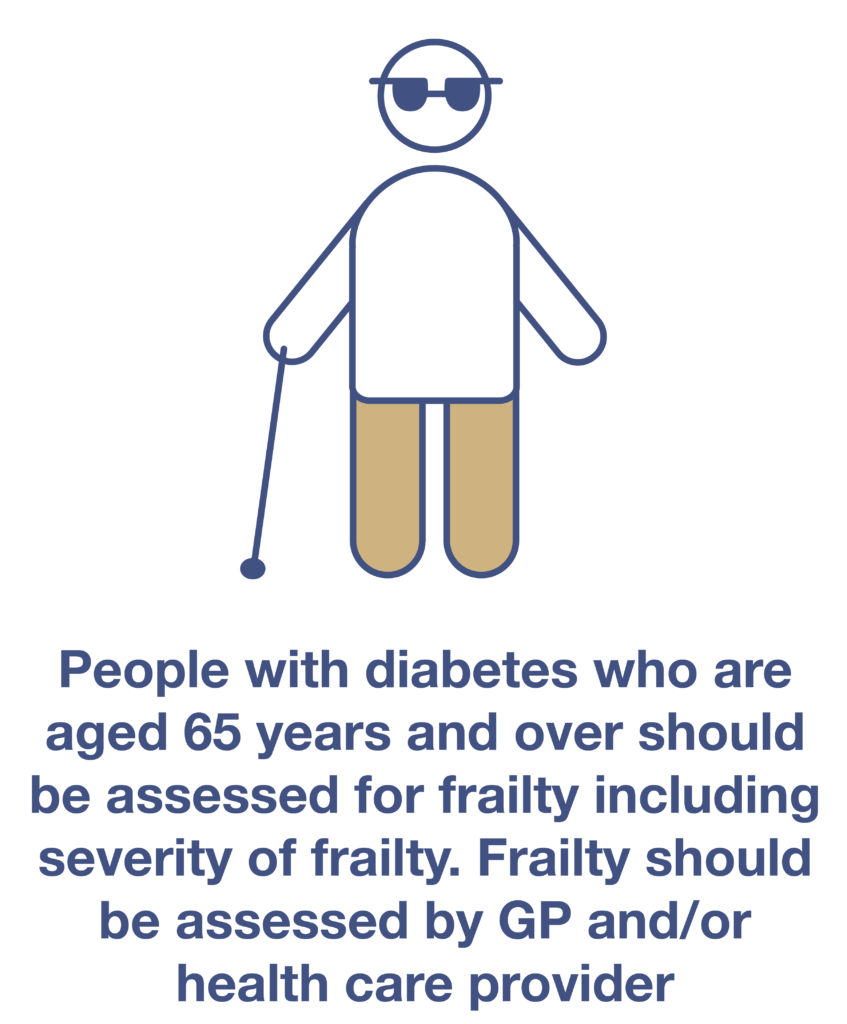Glucose levels are an important part of managing diabetes. Targets should be agreed by the person and or carer and health care professional. The purpose of agreeing targets is to provide a marker to help inform us of whether the person’s glucose levels are running too high, too low or within recommended targets. This is important to ensure the person is receiving a reasonable level of diabetes care to ensure they are safe and to avoid short and long term complications.
The aim of diabetes management of frail and older people living with diabetes is to avoid hypoglycaemia (low blood glucose) and hyperglycaemia (high blood glucose), which could lead to an increase in hospital admissions, and exacerbate other conditions that may affect their quality of life. There is guidance available stating recommended targets but these should be individualised and agreed by their GP and should be part of an individualised care plan.
Recommended glucose levels are difficult to define in the older age group and should be individualised according to their ability to function; other chronic conditions; frailty and cognitive ability1C.E. Hambling a,b,*, K. Khunti b, X. Cosc , J. Wens d, L. Martineze , P. Topsever f , S. Del Prato g, A. Sinclair h, G. Schernthaner i , G. Ruttenj , S. Seidu (2018) Original research. Factors influencing safe glucose-lowering in older adults with type 2 diabetes: A PeRsOn-centred ApproaCh To IndiVidualisEd (PROACTIVE) Glycemic Goals for older people A position statement of Primary Care Diabetes Europe. Elsevier Ltd on behalf of Primary Care Diabetes Europe2Sinclair A (2019) Key learning points: diabetes in older people with frailty accessed from: Key learning points: diabetes in older people with frailty | Key learning points | Guidelines in Practice 29/09/2021.
Hypoglycaemia is less than 4.0 mmol/l.
Aim for glucose target of 6 – 12 mmol/L.
Last days of life aim above 8.0 mmol/L
It is known that severe hypoglycaemia can lead to further cognitive decline and accelerate the aging process3Bruce DG; Davis WA; Casey GP; Clarnette RM; Brown SGA; Jacobs IG; Almeida OP; Davis TME (2009) Severe hypoglycaemia and cognitive impairment in older patients with diabetes: the Fremantle Diabetes Study.
Likewise hyperglycaemia can lead to infections, delay healing and increases the risk of cardiovascular complications and deterioration in other conditions and aspects of their lives. Guidelines for older adults living with diabetes recommend maintaining glucose levels within a range of 6 – 12 mmol/L.
The End of Life Diabetes Guidance recommend maintaining a glucose level above 8.0mmol/L4Diabetes UK END OF LIFE DIABETES CARE Clinical Care Recommendations 3rd Edition March 2018 https://diabetes-resources-production.s3.eu-west-1.amazonaws.com/resources-s3/public/2021-11/EoL_TREND_FINAL2_0.pdf (see section 18 on end of life care).
Targets should ideally be individualised, agreed and documented as part of their care plan: Blood Glucose Video
Day to day glucose monitoring tests

The aim of monitoring glucose levels is to keep people:
- safe
- avoid symptoms
- promote quality of life
Glucose tests should only be performed by those competent to do so and in accordance with local guidance. This may be done using a finger prick test or using technology such as ‘flash’ monitoring e.g. Libre monitoring systems.
Monitoring frequency should be advised by the health care professional. (see section for advice on glucose and ketone monitoring).

Intermittent (Flash) or
Continuous Glucose
Monitoring

This is available for people with diabetes who are on insulin; who may be having frequent or severe hypo’s; may be unable to finger prick or they need to glucose test eight or more times per day (NICE 2022). 5NICE (2022b) Type 1 diabetes in adults: diagnosis and management. NG17. NICE, London. Available at: https://www.nice.org.uk/ guidance/ng17; NICE (2022c); Type 2 diabetes in adults: management. NG28. NICE, London. Available at: https://www.nice.org.uk/guidance/ng28 (accessed 22/07/24). Quality statement 4: Continuous glucose monitoring for adults who use insulin and need help monitoring their blood glucose | Type 2 diabetes in adults | Quality standards | NICE (accessed 22/07/2024).
A small disc called a sensor, can be sited on various parts of the body. The sensor monitors glucose levels in the fluid (not in the blood). Results can be seen on a meter (known as a reader) and needs to be scanned or ‘flashed’ across the sensor at least every eight hours. Glucose readings can be viewed on a mobile (smart) phone or device continuously.
If glucose levels are low or high, the advice is to test blood glucose levels for accuracy at these times. Therefore people using this technology should still be prescribed blood glucose monitoring equipment and test strips.
HbA1c test
This is a blood test taken from a vein in the arm. It can be taken at any time of day. It is used to measure the amount of glucose in the blood over a period of 2 – 3 months and this is measured in mmol/mol. This blood test indicates how well managed a person’s diabetes is.
The table below recommends the HbA1c range based on the person’s frailty. So for example, in a fit older adult with diabetes we should aim to achieve a HbA1c of between 53 – 58 mmol/l6Strain W, Hope S, Green A, Kar P, Valabhji J, Sinclair A. Type 2 diabetes mellitus in older people: a brief statement of key principles of modern day management including the assessment of frailty. A national collaborative stakeholder initiative. Diabet Med 2018; 35 (7): 838–845..
The view is that very few people aged 70 years or over with diabetes benefit from having strict glucose levels with a HbA1c of less than 53 mmol/L7Clegg A, Bates C, Young J et al. Development and validation of an eletronic frailty index using routine primary care electronic health record data. Age Ageing 2016; 45: 353-360.
| Electronic Frailty Index Score8De Blase S. The Electronic Frailty Index Guidance Notes. Yorkshire and Humber Academic Health Science Network Improvement Academy. Available at: https://www.improvementacademy.org/ | Lower Threshold | Upper Threshold |
|---|---|---|
| The fit older adult with diabetes | HbA1c 53 mmol/mol | HbA1c 58 mmol/mol |
| Moderate severe frailty | HbA1c 58 mmol/mol | HbA1c 64 mmol/mol |
| Very severe frailty | HbA1c 64 mmol/mol | HbA1c 70 mmol/mol |
A clinical frailty scale produced by the National Institute for Health and Clinical Excellence8NICE guideline [NG159] (updated 2021) COVID-19 rapid guideline: critical care in adults provides some explanation to define frailty (for those in a critical care situation) but advises using this with caution in individuals under the age of 65 years

| An older adult who is assessed as having moderate frailty | According to the UK Frailty score this means they need help with all outside activities, housework including needing some assistance with personal care such as bathing and dressing. They may have difficulty with stairs. |
| The severely frail older adult | Completely dependent for personal care, whether it be due to physical or cognitive reasons. The scale states they may appear stable and not at high risk of dying within 6 months. |
| The very severely frail adult | Completely dependent and approaching end of life. They are unlikely to recover even from a minor illness.? |
Adapted from Strain S et al (2018) cited in Sinclair A (2019)
Frailty and Glucose Targets
People within the moderate to severe and very severe frailty group would be at a greater risk of hypoglycaemia (low glucose level) and its complications. Therefore, a realistic target for glucose levels and HbA1c would be set towards a higher level. This would be a safer approach to reducing risks of hypoglycaemia without causing symptoms of hyperglycaemia (high glucose levels) that may affect quality of life.
Further reading
Accessed from: Clinical Frailty Scale – Specialised Clinical Frailty Network (scfn.org.uk) on 28/09/2021
- People with diabetes who are aged 65 years and over should be assessed for frailty including severity of frailty
- Glucose targets should be sensible, safe, and appropriate
- The aim is to avoid hypoglycaemia and hyperglycaemia, which could lead to an increase in hospital admissions, and exacerbate other conditions that may affect their quality of life
- All older adults with diabetes and frailty should have their medications checked and reviewed by their health care professional at least annually, as part of their diabetes review9Sinclair A (2019) Key learning points: diabetes in older people with frailty accessed from: Key learning points: diabetes in older people with frailty | Key learning points | Guidelines in Practice 29/09/2021
07 Glucose Testing and Targets
- 1C.E. Hambling a,b,*, K. Khunti b, X. Cosc , J. Wens d, L. Martineze , P. Topsever f , S. Del Prato g, A. Sinclair h, G. Schernthaner i , G. Ruttenj , S. Seidu (2018) Original research. Factors influencing safe glucose-lowering in older adults with type 2 diabetes: A PeRsOn-centred ApproaCh To IndiVidualisEd (PROACTIVE) Glycemic Goals for older people A position statement of Primary Care Diabetes Europe. Elsevier Ltd on behalf of Primary Care Diabetes Europe
- 2Sinclair A (2019) Key learning points: diabetes in older people with frailty accessed from: Key learning points: diabetes in older people with frailty | Key learning points | Guidelines in Practice 29/09/2021
- 3Bruce DG; Davis WA; Casey GP; Clarnette RM; Brown SGA; Jacobs IG; Almeida OP; Davis TME (2009) Severe hypoglycaemia and cognitive impairment in older patients with diabetes: the Fremantle Diabetes Study
- 4Diabetes UK END OF LIFE DIABETES CARE Clinical Care Recommendations 3rd Edition March 2018 https://diabetes-resources-production.s3.eu-west-1.amazonaws.com/resources-s3/public/2021-11/EoL_TREND_FINAL2_0.pdf
- 5NICE (2022b) Type 1 diabetes in adults: diagnosis and management. NG17. NICE, London. Available at: https://www.nice.org.uk/ guidance/ng17; NICE (2022c); Type 2 diabetes in adults: management. NG28. NICE, London. Available at: https://www.nice.org.uk/guidance/ng28 (accessed 22/07/24). Quality statement 4: Continuous glucose monitoring for adults who use insulin and need help monitoring their blood glucose | Type 2 diabetes in adults | Quality standards | NICE (accessed 22/07/2024).
- 6Strain W, Hope S, Green A, Kar P, Valabhji J, Sinclair A. Type 2 diabetes mellitus in older people: a brief statement of key principles of modern day management including the assessment of frailty. A national collaborative stakeholder initiative. Diabet Med 2018; 35 (7): 838–845.
- 7Clegg A, Bates C, Young J et al. Development and validation of an eletronic frailty index using routine primary care electronic health record data. Age Ageing 2016; 45: 353-360
- 8NICE guideline [NG159] (updated 2021) COVID-19 rapid guideline: critical care in adults
- 9Sinclair A (2019) Key learning points: diabetes in older people with frailty accessed from: Key learning points: diabetes in older people with frailty | Key learning points | Guidelines in Practice 29/09/2021